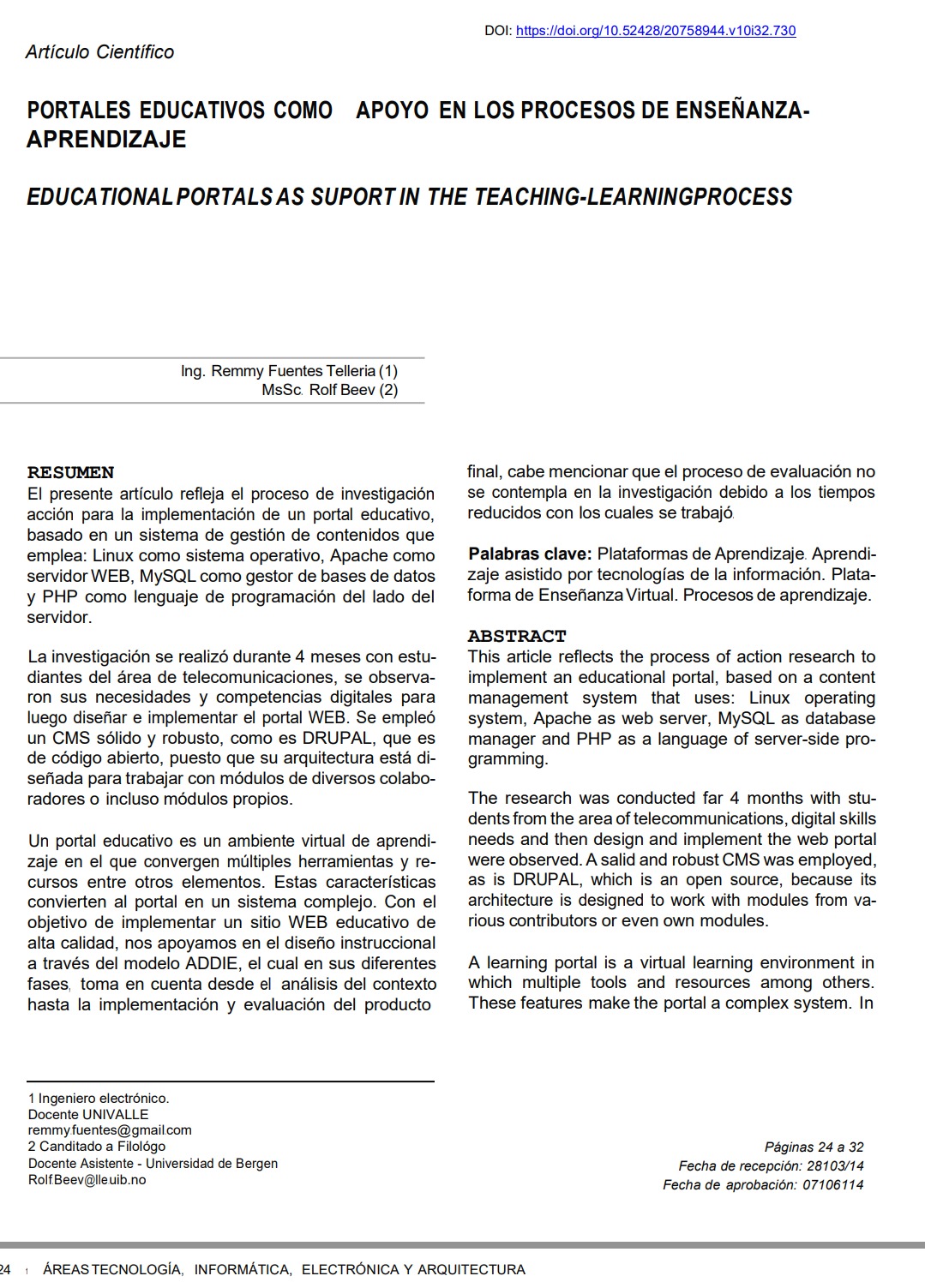Educational Portals as Support in the Teaching-Learning Process
DOI:
https://doi.org/10.52428/20758944.v10i32.730Keywords:
Learning Platforms, Assisted learning by information technology, Virtual Learning Platform, Learning processesAbstract
This article reflects the process of action research to implement an educational portal, based on a content management system that uses: Linux operating system, Apache as web server, MySQL as database manager and PHP as a language of serverside programming. The research was conducted far 4 months with students from the area of telecommunications, digital skills needs and then design and implement the web portal were observed. A salid and robust CMS was employed, as is DRUPAL, which is an open source, because its architecture is designed to work with modules from various contributors or even own modules. A learning portal is a virtual learning environment in which multiple tools and resources among others.
These features make the portal a complex system. In order to implement an educational web site quality, we rely on instructional design through the ADDIE model, which in its different phases, takes into account the context from analysis to implementation and evaluation of the final product, it mention that the evaluation process is not considered in the investigation due to the reduced time with which we worked.
Downloads
References
(1) CASTELLS M. La Era de la información: economía, sociedad y cultura. Volumen 2. 1 raed. Mexico DF: Siglo XXI; 1999.
(2) MCLUHAN M, CARPENTER E. El Aula sin muros: investigaciones sobre técnicas de comunicación. 2nd ed. Boston: Laia; 1981.
(3) GÉRTRUDIX BARRIO F. Los portales educativos como fuente de recursos y materiales. ÍCONO 14 • N7 Revista de comunicación y nuevas tecnologías. Madrid; 2006;17.
(4) UIT. Resumen Ejecutivo Medición de la Sociedad de la Información. Ginebra; 2012 p. 26.
(5) LÉVY P. Cibercultura: Informe al Consejo de Europa. 1 st ed. Barcelona: Anthropos Editorial; 2007.
(6) ELLIOTT J. La Investigación•acción en Educación. Madrid: Morata; 1990.
(7) DEWEY J. Cómo pensamos. Barcelona: Paidós; 2007
(8) KEMMIS S, MACTAGGART R. Cómo planificar la investigación•acción. Laertes editorial, S.A.; 1988.
(9) OCDE O. PARA LA C Y EL DE. Habilidades y competencias del siglo XXI para los aprendices del nuevo milenio en los países de la OCDE. París; 201 O p. 41.
(10) WILLIAMS P, SCHRUM L, SANGRA A, GUARDIA L. Modelos de diseño lnstruccional Fundamentos del diseño técnico pedagógico en el elearnig. Barcelona: FUOC; 2004.
(11) MUÑOZ CARRIL PC. Modelos de diseño instruccional utilizados en ambientes teleformativos. Revista de Investigación Educativa ConeCT@2 N 2. Santiago de Compostela; 2011 ;62.

Downloads
Published
How to Cite
Issue
Section
License
Copyright (c) 2014 Remmy Fuentes Telleria y Rolf Beev

This work is licensed under a Creative Commons Attribution 4.0 International License.
Authors who publish with this journal agree to the following terms:
- Authors retain copyright and grant the journal right of first publication with the work simultaneously licensed under a Creative Commons Attribution License 4.0 that allows others to share the work with an acknowledgement of the work's authorship and initial publication in this journal.
- Authors are able to enter into separate, additional contractual arrangements for the non-exclusive distribution of the journal's published version of the work (e.g., post it to an institutional repository or publish it in a book), with an acknowledgement of its initial publication in this journal.
- Authors are permitted and encouraged to post their work online (e.g., in institutional repositories or on their website) prior to and during the submission process, as it can lead to productive exchanges, as well as earlier and greater citation of published work.














